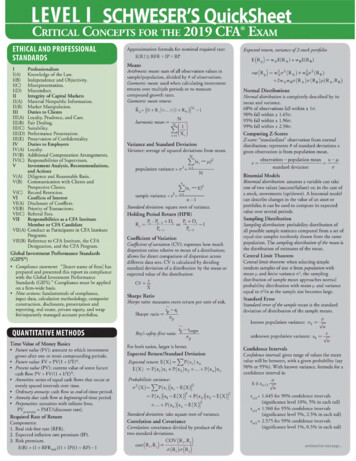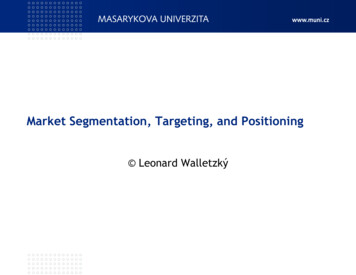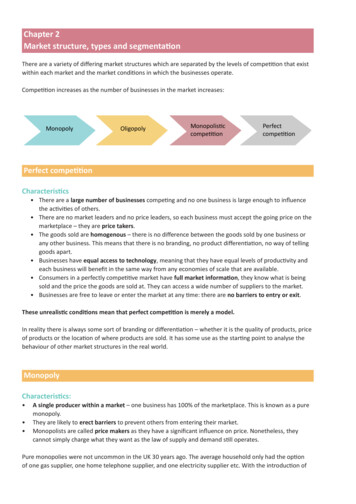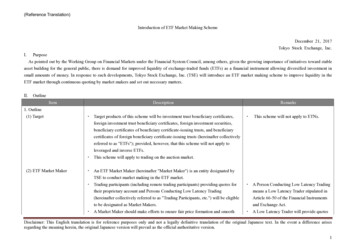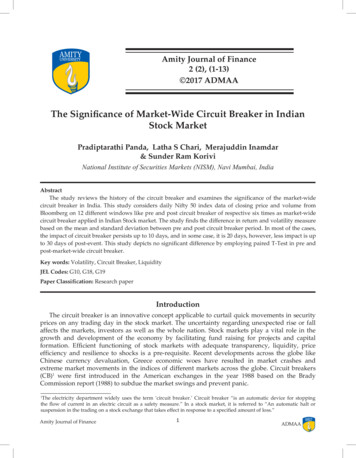
Transcription
Volume 2 Issue 2 2017AJFAmity Journal of Finance2 (2), (1-13) 2017 ADMAAThe Significance of Market-Wide Circuit Breaker in IndianStock MarketPradiptarathi Panda, Latha S Chari, Merajuddin Inamdar& Sunder Ram KoriviNational Institute of Securities Markets (NISM), Navi Mumbai, IndiaAbstractThe study reviews the history of the circuit breaker and examines the significance of the market-widecircuit breaker in India. This study considers daily Nifty 50 index data of closing price and volume fromBloomberg on 12 different windows like pre and post circuit breaker of respective six times as market-widecircuit breaker applied in Indian Stock market. The study finds the difference in return and volatility measurebased on the mean and standard deviation between pre and post circuit breaker period. In most of the cases,the impact of circuit breaker persists up to 10 days, and in some case, it is 20 days, however, less impact is upto 30 days of post-event. This study depicts no significant difference by employing paired T-Test in pre andpost-market-wide circuit breaker.Key words: Volatility, Circuit Breaker, LiquidityJEL Codes: G10, G18, G19Paper Classification: Research paperIntroductionThe circuit breaker is an innovative concept applicable to curtail quick movements in securityprices on any trading day in the stock market. The uncertainty regarding unexpected rise or fallaffects the markets, investors as well as the whole nation. Stock markets play a vital role in thegrowth and development of the economy by facilitating fund raising for projects and capitalformation. Efficient functioning of stock markets with adequate transparency, liquidity, priceefficiency and resilience to shocks is a pre-requisite. Recent developments across the globe likeChinese currency devaluation, Greece economic woes have resulted in market crashes andextreme market movements in the indices of different markets across the globe. Circuit breakers(CB)1 were first introduced in the American exchanges in the year 1988 based on the BradyCommission report (1988) to subdue the market swings and prevent panic.The electricity department widely uses the term ‘circuit breaker.’ Circuit breaker “is an automatic device for stoppingthe flow of current in an electric circuit as a safety measure.” In a stock market, it is referred to “An automatic halt orsuspension in the trading on a stock exchange that takes effect in response to a specified amount of loss.”1Amity Journal of Finance1ADMAA
AJFVolume 2 Issue 2 2017The question of whether the circuit breaker contributes to market resilience or not is widelydebated by researchers and market practitioners.Circuit breakers are applied in different forms across different exchanges globally. Thoseare – (i) price limits, i.e., stock wise trading halts, (ii) firm-specific trading halts and (iii) marketwide circuit breakers. In each of the cases, the circuit breaker is applicable for both upper andlower movements. Market wide circuit breaker and stock wise price limits are two popularcircuit breakers applied in all stock exchanges. If index (broad-based) breaches a predeterminedlevel, the trading is halted across the cash and derivative segments of the exchange or across allexchanges operating in the country, for a specified time. This is known as the market-wide circuitbreaker. Trading may resume the same day or next day depending upon the time at which theoriginal breach on the level of the index takes place in the market. As against this in stock-basedprice limits, price levels are fixed (upper and lower) and once the last traded price reaches thislevel, the stock is supposed to be in the upper circuit or lower circuit. Unlike the circuit breaker,the trading in the stock is not halted. A trade can be performed within the boundaries of the pricelimits if there are willing buyers and sellers with matching prices in the stock. Circuit breakers andprice limits affect trading in different ways, even though both aim at reducing market volatilityand bringing in market stability by reducing information asymmetry.“Stock Markets whether American or Chinese are volatile and often are very unstable.Circuit Breakers can provide stability to financial markets provided they are designed correctly;otherwise, they can create more instability. China has to learn, and they have to design correctly.”(Joseph Stiglitz, Nobel Laurate and Professor, Columbia University, ET-12/Jan/2016)The Rationale For and Against Circuit Breakers/Market HaltsAn unexpected movement in stock prices/ index affects liquidity and increases volatility inthe market. They may create panic conditions by triggering widespread margin calls and tradingdisruptions. There are different schools of thought on the significance of the circuit breaker in thestock market. The school of thought that accepts the benefits of circuit breakers are as follows. Forshort-term investors and traders, bringing the market to halt will provide time to understand andgauge the impact of news on the prices (Kim et al. 2008). Such a halt will minimize instability,reduce volatility, aid efficient price discovery and protect value (Kim et al. 2007). Greenwald &Stein (1991) depict that when uninformed traders move prices away from fundamentals (based onthe news) informed traders feel uncertain about prices and tend to withdraw their positions fromthe market to avoid ‘transaction risk.’ In dealer driven markets, where firm quotes are made bydealers, the circuit breaker mechanism, not only brings trading to halt but also allows cancellationof all orders and helps to improve liquidity by providing time to traders to reposition their trade.It protects liquidity providers from huge losses. From a broker perspective, trading halts providetime to brokers to interact with their clients, provide information to them, collect margins ifrequired, distribute risk and help in reducing the possibility of defaults. (IOSCO, 2002). Regulatorsbelieve that by simulating liquidity, halting free fall, they can protect clearing houses from clearingand settlement defaults and ensure that there is no systemic threat to markets. Kobayashi &Hashimoto (2011) used an artificial market simulator “U-Mart” and concluded that circuit breakerplays an important role to reduce volatility, price fluctuations and the trading volume.The school of thought opposing the benefits of circuit breaker argues that “trading halts createuncertainty about the size of order imbalance and slow down the speed of price adjustmentprocess” (Grossman, 1990). It causes a “delay in price adjustment, increases trading opportunityADMAA2Amity Journal of Finance
Volume 2 Issue 2 2017AJFcost, increases post-halt volatility” (Kim and Rhee, 1997). When markets re-open after the halt, thepost-halt volatility also increases (Fong 1996).Haris (1998) used a different parameter like psychological, economical and statistical whichshows that circuit breaker policy in US stock exchanges does not have a large effect on volatility.S&P 500 stock (TASE) shows trading halts and price limits had no significant impact on the overalldecline (Lauterbach & Ben-Zion, 1993). Gerety & Mullehrin (1992) depict pre-open and end sessionusually has high volatility as it is a market phenomenon but halting ownership to sell to those whoare willing to buy creates a negative environment.The ex-ante effect of the circuit breaker is studied by Subrahmanyam (1994) and concluded thecircuit breaker yields the opposite result which regulator wants from the circuit breaker. Circuitbreaker prevents the bad market quality to become the worst market quality. It is a useful tool forpromoting market wide stability (Brugler & Linton, 2014). Christie et al. (2002) find post-tradinghalts follow the unusually high volatility even when the halting mechanism allows for informationtransmission during the halt.Research GapThe study finds most of the existing studies have been conducted on the developed marketthat is the quote-driven markets. Indian markets are order driven markets. Here, no marketparticipant is under obligation to provide liquidity. Hence, it is possible that under conditions ofprice uncertainty, all the market participants can withdraw simultaneously, and this may affectmarket quality adversely and lead to systemic failures. Previous researches that have attemptedto study the impact of stock-specific trading halt in order driven markets include Kim et.al (2008),A Frino et. al. (2011), Engelen and Kabir (2006), Kim and Rhee (1997) using the data of Spanish,Australian, Euro-next Brussels, Japan respectively. Christie et al. (2002) find both sharing volumeand the numbers of trades are over six times than normal level during the 30 minutes after thehalt. It remains unusually high for up to two hours.There are no studies assessing the impact of market-wide circuit breakers and trading halt onthe market quality in India. This may also be because there are only six such occasions in the pastwhen the Indian exchanges have halted trading since 2001. In the light of latest developmentsin emerging markets like China, it is felt that a study of the effectiveness of market-widecircuit breakers and its impact on market quality will provide necessary inputs to regulatorsand exchanges for policy decisions. With the above motivation, the objective of this study is tounderstand the current regulations related to market-wide circuit breakers in India and to measurethe impact of market-wide circuit breakers on liquidity and volatility.Methodology and Data SourcesMethodology:First, all data series has been converted into natural logarithm by formula-ln (pt/pt-1)*100Where -pt is current day pricept-1 is the previous day priceFor analysis, the study first presents descriptive statistics to know the nature of data series,especially to measure volatility regarding standard deviation and to measure the mean of differentAmity Journal of Finance3ADMAA
AJFVolume 2 Issue 2 2017periods. Further, this study applied paired T-test to know the significant difference between themean value of two series like pre and post circuit breaker period. By applying these tests, liquidityand volatility has been measured for pre and post circuit breaker.The study considers both volume and closing price of the Nifty index in six different eventsof market-wide circuit breaker applied in Indian markets. The dates, causes, and types of circuitbreaker have been given in Table-1.Table-1: Market Wide Circuit Breaker applied in Indian Stock MarketDateEventCircuit TypeMay 17, 2004, MondayNDA Government lost. UPA returned to power withthe help of left parties.Lower circuit breakerMay 22,2006, MondayConcerns about margin pressure and taxation issues.Lower circuit breakerOctober 17, 2007, WednesdayOn 16th October 2007 night, SEBI proposed to clamp Lower circuit breakerdown on participatory notes (PNs) to restrict foreigninflowsJanuary 22, 2008, TuesdayThe subprime crisis and Global financial meltdownLower circuit breakerMay 18, 2009, MondayUPA own the 15th Lok Sabha electionUpper circuit breakerOctober 05, 2012, FridayNSE System problem and trading halted due toerroneous orders entered on behalf of an institutionalclient.Lower circuit breakerData Sources- The data of closing price and volume of Nifty 50 index for before ten daysand after ten days, before 20 days and after 20 days & before 30 days and after 30 days has beenconsidered of all the six times of market-wide circuit breakers that has been applied in India. Alldata are sourced from Bloomberg.Regulation Related to the Market-Wide Circuit BreakerThe regulations related to market-wide circuit breakers vary from country to country. Thesurvey report of World Federation of Exchanges, 2008 highlights the differences in circuit breakerrules across the globe. Out of 40 exchanges that have participated in the survey, 16 exchanges donot have any circuit breaker mechanism in place.In India, the regulation related to the application of market-wide circuit breaker wasintroduced on 28th June 20012 by Securities Exchange Board of India (SEBI). The objective was toprovide time to market participants to absorb and evaluate the information causing steep pricefluctuations and react on that basis thereby prevent a panic reaction. Further, it was also felt thatthe halt will help to preserve market stability, manage default risks as brokers and clients willhave time to arrange and provide funds to meet margin calls which may be triggered due to steepprice movements. Based on the market experience and reactions, the regulations initiated by SEBIin 2001, have been modified and changed and the current regulations related to the application ofmarket-wide circuit breakers are as given below:SEBI circular no. SMDRPD/Policy/Cir-37/2001 dated 28th June 2001.2ADMAA4Amity Journal of Finance
Volume 2 Issue 2 2017AJFThe regulation provides for the implementation of the trading halt at three different levels ofindex movements. Movement of SENSEX or NIFTY index in either direction by 10%, 15% and20% concerning the previous days close, shall trigger the market-wide circuit breaker, upon whichboth the stock exchanges are required to halt trading in all equity and equity derivative marketsegments in a coordinated manner. The duration of the halt in case of a 10% movement of eitherof these indices, shall be 1-hour market halt if the movement takes place before 1 pm. In case themovement takes place at or after 1 pm but before 2:30 pm, then there will be a trading halt for ½hour. In case the movement takes place at or after 2:30 pm, then there will be no trading halt at the10% level, and the market will continue trading.In the case of a 15% movement of either index, there will be a 2-hour halt if the movement takesplace before 1 pm. If the 15% trigger is reached on or after 1 pm but before 2 pm, then there willbe a 1-hour halt. If the 15% trigger is reached on or after 2 pm, then the trading will halt for theremainder of the day.In case of a 20% movement of the index, the trading will be halted for the remainder of the day.The exchanges shall also purge the unmatched orders present in the electronic order book. Themarket shall further open after the specified time, with a 15-minute pre-market call auction sessionin the equity cash segment to facilitate price discovery.Empirical ResultsDescriptive statistics are designed to know the information about the variables. Beforeapplying the T-test, the study starts with the presentation of descriptive statistics of stock returnsand volume returns for pre and post circuit breaker period. The mean in the descriptive statisticsshows the average of the series (mean is the sum of the values of a variable divided by the numberof observation), the standard deviation (SD) is the variance of the series (SD is the positive squareroot of the variance). Variance is the sum of the squared deviations of each value from the meandivided by the number of observations. Max and Min present the maximum and minimummovement of a data series over a period. Skewness measures the distribution is positively skewedor negatively skewed. Kurtosis measures the peaked or flat distribution. For a normal distributionSkewness should be zero, kurtosis is 3, and the Jarque-Bera (J-B) statistics should be zero. If J-B ismore than zero, than the series is non-normal (Gaur et al. 2006). Paired sample T-Test is done tomeasure whether the mean value of two different periods is significantly different from each otheror not.The descriptive statistics have been presented in Table-2 for the year 2004, Table-3 for the year2006, Table-4 for the year 2007, Table-5 for the year 2008, Table-6 for the year 2009 and Table- 7 forthe year 2012. The paired T-test is presented in the Table-8.Amity Journal of Finance5ADMAA
AJFVolume 2 Issue 2 2017Table-2: Descriptive Statistics for the year 200410 DaysNifty Return Pre wnessKurtosisJB-1.2443.4692.405Nifty Return 3Volume Pre me Post ty Return Pre fty Return 2Volume Pre Volume Post ty Return Pre fty Return Post e Pre olume Post CB-1.018-0.60842.323-27.72316.4870.5853.0291.65720 Days30 Days* represents 1% level of significanceTable-2 presents the descriptive statistics of the Nifty return and return of Nifty volume forthe year 2004. Based on mean, Nifty return reduces in the post circuit breaker period and volumesare also reduced more than nifty returns in case of 10, 20 and 30 observations. The volatility ofboth Nifty return and return of Nifty volume as measured by standard deviation has increased incase of 10 trading days’ observations and 20 trading days’ observations; however is decreased incase of 30 trading days’. This indicates as one moves from circuit breaker day, there is an increasein volatility up to 20 trading day and after that, it starts to decrease. Skewness here indicates alldata series are positively and negatively skewed means asymmetrically distributed. All valueof Kurtosis in three different windows are positive, indicates that data series are leptokurtic,implying a more peaked distribution than the normal distribution. The value of Jarque-Berastatistics indicates that data are normal in some cases and non-normal in some cases.Table-3: Descriptive Statistics for the year 200610 DaysMeanMedianMax.Min.SDSkewnessKurtosisJBNifty Return Pre CB-1.43-1.3873.123-7.0133.190-0.3712.1550.474Nifty Return Post e Pre lume Post fty Return Pre CB-0.4680.4253.123-7.0132.537-1.0283.5883.623Nifty Return Post e Pre lume Post fty Return Pre y Return Post CB-0.0780.1656.114-4.8743.0120.2722.0891.358Volume Pre olume Post 3*20 Days30 Days* represents 1% level of significanceADMAA6Amity Journal of Finance
Volume 2 Issue 2 2017AJFTable-3 presents the descriptive statistics of the Nifty return and return of Nifty volumefor the year 2006. Based on mean, Nifty return increases in the post circuit breaker periodand volumes reduce in case of 10 trading days’ observations, 30 trading days’ observationsand increase in case of 20 observations. The volatility of both Nifty return and return of Niftyvolume as measured by standard deviation has increased in all cases except in ten observations,where it has been decreased. This indicates that the volatility increases after application ofmarket wide circuit breaker. Skewness here indicates, all data series are asymmetricallydistributed. All value of Kurtosis in three different windows are positive and indicates that dataseries are leptokurtic, implying a more peaked distribution than the normal distribution. Thevalue of Jarque-Bera statistics indicates data are normal in maximum cases and non-normal insome cases.Table-4: Descriptive Statistics for the year 200710 DaysMeanMedianMax.Min.SDSkewnessKurtosisJBNifty Return Pre CB0.935-0.0414.652-1.9612.4190.4231.8910.730Nifty Return Post CB1.0860.5425.437-2.5672.4090.3762.4710.316Volume Pre lume Post fty Return Pre CB1.1600.9434.652-1.9611.8660.3322.4670.575Nifty Return Post CB0.0050.0000.054-0.0250.0200.8653.0032.373Volume Pre me Post *Nifty Return Pre CB0.8110.3204.652-1.9611.6070.8483.4243.691Nifty Return lume Pre me Post *20 Days30 Days* represents 1% level of significanceTable 4 presents the descriptive statistics of Nifty return and return of Nifty volume for theyear 2007. Based on mean, Nifty return decreases in the post circuit breaker period except itincreases for 10 observations. The Nifty volume reduces in case of all trading days. Volatility ofboth Nifty return and return of Nifty volume as measured by standard deviation has increasedin all cases except for 10 observations and in Nifty return for 20 observations decreased. Thisindicates that volatility starts increasing from circuit breaker day. Skeweness here indicates,all data series are asymmetrically distributed. Value of Kurtosis in three different windows ispositive indicates, data series are leptokurtic implying a more peaked distribution than normaldistribution. The value of Jarque-Bera statistics indicates data to be normal in maximum cases andnon-normal in two cases.Amity Journal of Finance7ADMAA
AJFVolume 2 Issue 2 2017Table-5: Descriptive Statistics for the Year 200810 DaysMeanMedianMax.Min.SDSkewnessKurtosisJBNifty Pre y Post CB0.5840.1276.721-3.3213.1960.6652.4870.762Volume Pre me Post fty Pre ty Post CB0.077-0.2516.720-5.283.0830.4212.7330.619Volume Pre ume Post CB-3.5061.92561.602-56.36624.1390.3254.8002.90020 days30 DaysNifty Pre ty Post e Pre ume Post CB1.8631.15450.160-63.38624.710-0.2453.3200.413* represents 1% level of significanceTable 5 presents the descriptive statistics of the Nifty return and return of Nifty volume forthe year 2008. Based on mean, Nifty return decreases in the post circuit breaker period except for30 observations. The volatility of both Nifty return and return of Nifty volume as measured bystandard deviation has increased in all cases excluding 20 observations, where the only volume ofnifty return has decreased. This indicates, as one moves from circuit breaker day, volatility startsincreasing. Skewness here indicates, all data series are asymmetrically distributed. All values ofKurtosis in three different windows are positive and that indicates data series are leptokurtic,implying a more peaked distribution than the normal distribution. The value of Jarque-Berastatistics indicates data are normal in maximum cases and non-normal in two cases.Table-6: Descriptive Statistics for the year 200910 DaysMeanMedianMax.Min.SDSkewnessKurtosisJBNifty Pre CB0.053-1.0113.496-1.842Nifty Post .0882.072Volume Pre 599Volume Post 451-0.2155.053-3.1512.1600.4662.3750.9960.39320 DaysNifty Pre CBNifty Post CB0.1970.1203.797-3.4821.961-0.0892.317Volume Pre olume Post *Nifty Pre CB0.5730.4415.053-4.2882.343-0.0682.4730.356Nifty Post CB0.0570.2773.798-3.6431.960-0.1212.3040.656Volume Pre lume Post 0 Days*** represents 10% level of significanceADMAA8Amity Journal of Finance
Volume 2 Issue 2 2017AJFTable 6 presents the descriptive statistics of the Nifty return and return of Nifty volume forthe year 2009. This is the only case where the upper circuit was applied. Based on mean, Niftyreturn increases in the post circuit breaker period up to 10 trading days but decreases in case of 20and 30 trading days. The volatility of both Nifty return and return of Nifty volume as measuredby standard deviation has decreased in maximum cases except in ten trading days’ Nifty returnand 20 trading day’s volume of Nifty return; it has increased. This indicates that volatility startsdecreasing from circuit breaker day. Negatively skewed means data series are asymmetricallydistributed. All value of Kurtosis in three different windows are positive and that indicates, dataseries are leptokurtic implying a more peaked distribution than the normal distribution. The valueof Jarque-Bera statistics indicates normal data except in one case.Table-7: Descriptive Statistics for the year 2012MeanMedianMax.Min.SDSkewnessKurtosisJBNifty Pre CB10 Days0.4570.2172.434-0.3790.8851.2843.7472.685Nifty Post CB0.0160.1971.027-0.9230.7390.1481.5400.831Volume Pre me Post fty Pre CB0.5240.2712.584-0.8210.9251.0223.2463.359Nifty Post CB0.0260.1971.027-1.2020.673-0.1911.9161.04520 DaysVolume Pre Volume Post fty Pre CB0.2290.0882.584-1.0690.9101.0573.9236.434**Nifty Post CB-0.0640.0021.027-1.2020.628-0.0182.0021.20430 DaysVolume Pre olume Post ** & ** represents1% & 5% level of significanceTable-7 presents the descriptive statistics of Nifty return and return of Nifty volume for theyear 2012. Based on mean, the study observes nifty return decreases in the post circuit breakerperiod in all trading days. Volatility of both Nifty return and return of Nifty volume as measuredby standard deviation has decreased in all cases. This indicates circuit breaker helps to decreasevolatility. Negatively skewed means data series are asymmetrically distributed. Kurtosis in threedifferent windows are positive indicates data series are leptokurtic implying a more peakeddistribution than normal distribution. The value of Jarque-Bera statistics indicates data are normalexcept two cases.Amity Journal of Finance9ADMAA
AJFVolume 2 Issue 2 2017Table-8: Paired T-Test Result for Pre and Post Circuit Breaker10 Days20 Days30 DaysDates of VolumeMay 17, 0.979(0.33)-0.497(0.62)May 22, .257(0.80)-0.203(0.84)October 17, 1.220(0.23)-0.583(0.57)January 22 )0.399(0.70)-0.369(0.71)0.797 .217(0.82)-1.590(0.12)0.099(0.92)May 18, 2009October 05 2012NB: numbers in the parenthesis are p valuesTable-8 tests the significant difference of mean between pre and post circuit breaker period forall six times of both Nifty return and Nifty volume return. The study employs paired T-test forthe closing price and volume of six different dates for 10, 20 and 30 days. No significant meandifference is found between pre and post circuit breaker periods except for three cases- closingprice for May 2006, October 2007 and October 2012. Based on the T-Test, the circuit breaker doesnot help to improve market quality.Table-9 presents key movements of the market on the day of the circuit breaker for six differenttimes.Table-9: Key movements of the market on the day of Circuit Breaker/Circuit Breaker in IndianMarketDateOpenHighLowCloseNumber ofshares tradedTurnover(Rs. Cr.)May 17, 2004, 17May 22,2006, ctober 17, 2007, 73January 22, 2008, 4May 18, 2009, Monday3673.154384.33673.152,768,292113.99October 05, 2012, Friday58155815.354888.2255,569,80412995.85746.95* Maximum circuit breaker was on May and MondayConclusion and Policy ImplicationThis study attempted to examine the impact of market wide circuit breaker on Indian stockmarket liquidity and volatility. The summary results of Table 2-7 have been presented in Table-10and 11. So, Monday and May are more sensitive for Indian stock market. This study observesmaximum circuit breakers were applied on Monday as well as in the month of May and Octoberin Indian stock market. The Election result caused more fluctuation in prices and reached circuitbreaker. Punching of false order also caused circuit breaker as it is evident from 17th OctoberADMAA10Amity Journal of Finance
Volume 2 Issue 2 2017AJF2012. Volatility decreased during Pre and post circuit breaker period. Based on mean, there existdifferences between pre and post circuit breaker and based on T-test, no significant difference inmean during pre and post circuit breaker is found except 2-3 cases. Difference and significancedifference are two different things. Hence application of market-wide circuit breaker is not addingthat much value to the market quality. If the circuit breaker can’t reduce volatility in the market,then the exchange should adopt call auction for price discovery again at the time of circuit breaker.Indian Markets are stronger than other markets like China. The scope for further research is tofind out the company wise impact based on event study during application of market wide circuitbreakers in India. A comparison of several countries during market wide circuit breaker can be aninteresting one to inve
Circuit breakers are applied in different forms across different exchanges globally. Those are – (i) price limits, i.e., stock wise trading halts, (ii) firm-specific trading halts and (iii) market-wide circuit breakers. In each of the cases, the circuit breaker is applicable for


